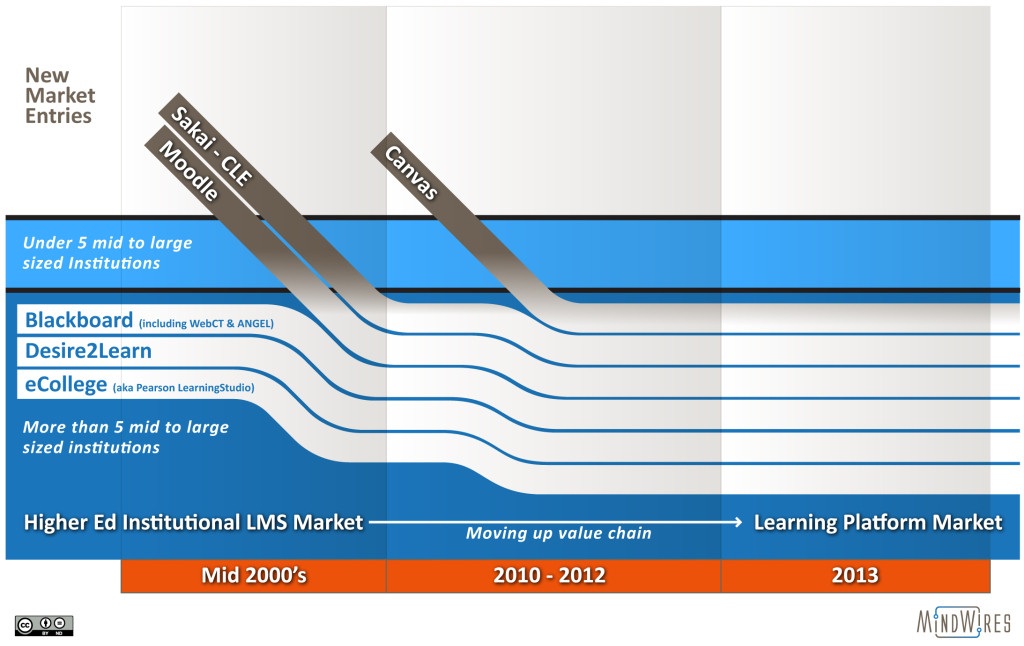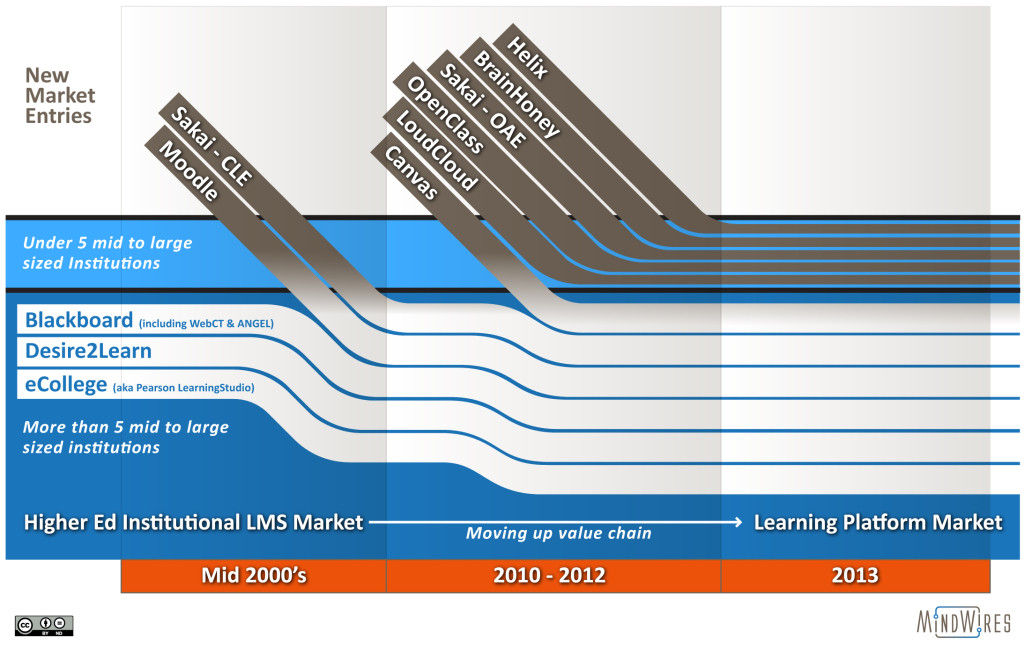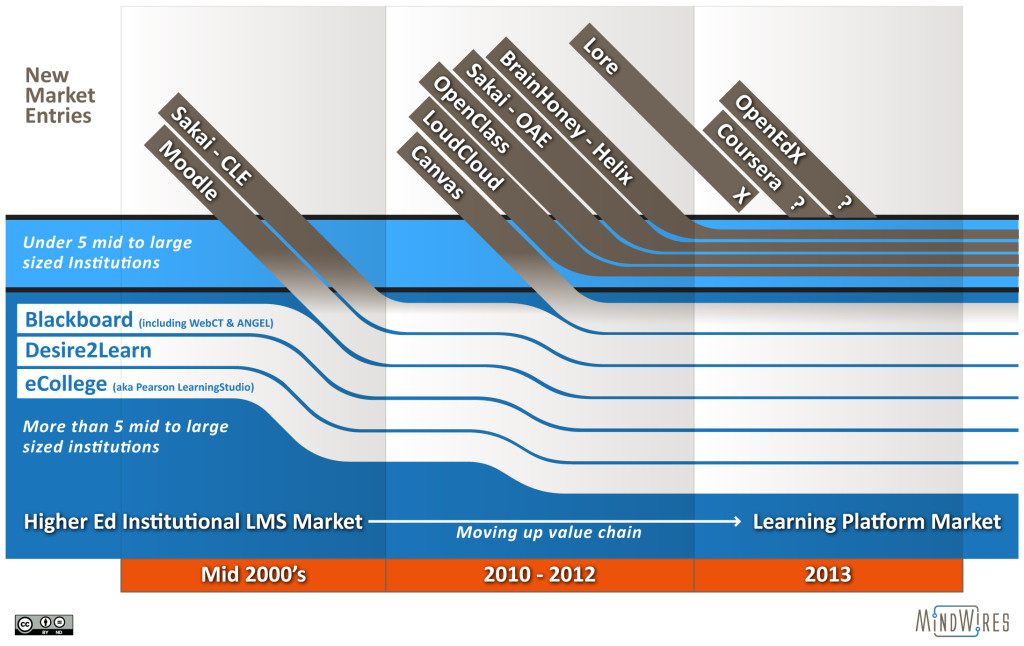For a few years starting in 2009, it seemed one of the best ways to raise VC funds or corporate internal investment was to say “we can beat Blackboard with a new cloud-based platform”. Witness Coursekit / Lore, Instructure / Canvas, OpenClass, LoudCloud Systems, Helix, and even more recently MOOC platforms. There were many articles written as these new systems entered the market, but what if we look back and ask whether the LMS market has actually changed recently? The picture that emerges is one of surprising resiliency by the established LMS providers.
In fact, I would argue that in the past eight years (at least in North America) the only new system that has fully established itself in the LMS market is Canvas. Note that I have combined WebCT and ANGEL within the Blackboard umbrella, but even these systems established themselves more than a decade ago.
In the mid 2000’s, we had Moodle and Sakai CLE join Blackboard, WebCT, ANGEL, Desire2Learn and eCollege as LMS solutions with staying power (let’s say based on having at least 5 mid to large-sized institutional adoptions). Then we have stasis until Canvas emerged in late 2010 (Utah Education Network selection) and early 2011. In just three years of production, Instructure boasts of 600+ institutional clients and 10 million end users for the Canvas platform.
There were other LMS announcements, and several of these systems are still available but have not demonstrated that they are fully established and have a sustainable business model. These can be shown as sitting on the edge of the market – not fully in and not fully out.
LoudCloud Systems initially targeted for-profit schools, with early wins at Grand Canyon University, Career Education Corp, and a big K-12 win in Colorado. Since then the company has advanced the product line and grown the company, but I have not seen any significant new wins.
OpenClass from Pearson seemed to dominate the conversation at EDUCAUSE 2011 as a “completely free”, “amazing” solution that was going to change the market. Initially targeted at faculty adoption rather than institutional adoption (it now targets both), the system does claim over 300,000 students and 50,000 faculty end users. But there are only a few institution-wide adoptions such as Abilene Christian University, and I am not convinced that 300,000 students using a free system rises to the level of a sustainable model.
Sakai OAE (rebranded last year as Apereo OAE – I’ll change this in future versions of the graphic) has gone through near-death and rebirth as we have described here at e-Literate. It is not truly targeted at being an LMS replacement, however, and is currently used at a handful of schools (Cambridge, Georgia Tech, Marist, NYU). Although this is not fully an LMS, I share it here under its original name for perspective as it was at one point billed as the replacement for Sakai CLE.
BrainHoney is an LMS more targeted at K-12 schools, but with BYU’s adoption as well as its inclusion in the University System of Maryland’s master agreement there had been signs they would fully compete in the higher ed space. But there has been no apparent follow-up.
Helix is the LMS developed by Altius Education with a particular focus on personalization and competency-based program support. After the Tiffin University / Ivy Bridge College loss of accreditation, the Helix platform was acquired by Datamark to expand their service offerings.
And finally there has been at least one example of an LMS that has come and gone, and two MOOC platforms that have shown signs of competing as the main learning platform for an institution.
Lore came out as Coursekit, and they had the most blatant pitch of “we’re better than Blackboard” as well as the biggest PR push (NY Times, the Economist, Forbes, TechCrunch, Fast Company, IHE, Chronicle, etc) outside of OpenClass. Alas, Lore as a company was short-lived and the technology was acquired by Noodle last year.
At one point Coursera made statements that they were beginning to compete in the LMS market. There has not been any visible follow-up to these moves, however.
OpenEdX is the open-source learning platform used by edX and has been available to institutions since July 2013. It is too early to tell what level of adoption this platform will have.
Does this mean that analysts and reporters (including myself) were wrong about the potential for the new systems to change the market? To a degree, yes. Look at the standard list of LMS solutions in most higher ed selection processes now and back in 2010 – Blackboard, Desire2Learn, Moodle, and Sakai remain; the primary change is the addition of Canvas.
At the same time, there have been fairly significant changes in the LMS market in the past few years, certainly influenced by the success of Canvas but perhaps also influenced by the other recent announcements. LMS pricing power has significantly shifted from established vendors to higher ed customers. Vendors are quite willing to be aggressive in their proposals, either to win a new client or to retain a client. Furthermore, all solutions seem to be much more open as systems, at least in terms of standards compliance, particularly with LTI (learning tools interoperability from IMS).
The bigger change in the market might be the clear direction of mainline LMS providers towards becoming learning platforms that act as the hub of an ecosystem of learning applications. There are varying degrees of success in achieving this goal, but most solutions aspire to be such platforms.
I do not believe that the LMS is a commodity – which LMS a school selects can make a real, long-term impact. I also believe that schools should not ignore the trajectory of the various providers.
Nevertheless, despite the flurry of investment in new solutions, the higher ed LMS market has not changed nearly as much as many people had anticipated.
Full disclosure: Pearson and Coursera have been MindWires Consulting clients.


